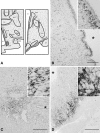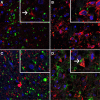Decreased serotonin transporter immunoreactivity in the human hypothalamic infundibular nucleus of overweight subjects
- PMID: 24860418
- PMCID: PMC4030197
- DOI: 10.3389/fnins.2014.00106
Decreased serotonin transporter immunoreactivity in the human hypothalamic infundibular nucleus of overweight subjects
Abstract
Context: That serotonin plays a role in the regulation of feeding behavior and energy metabolism has been known for a long time. Serotonin transporters (SERT) play a crucial role in serotonin signaling by regulating its availability in the synaptic cleft. The neuroanatomy underlying serotonergic signaling in humans is largely unknown, and until now, SERT immunoreactivity in relation to body weight has not been investigated.
Objective: To clarify the distribution of SERT immunoreactivity throughout the human hypothalamus and to compare SERT immunoreactivity in the infundibular nucleus (IFN), the human equivalent of the arcuate nucleus, in lean and overweight subjects.
Design: First, we investigated the distribution of serotonin transporters (SERT) over the rostro-caudal axis of six post-mortem hypothalami by means of immunohistochemistry. Second, we estimated SERT immunoreactivity in the IFN of lean and overweight subjects. Lastly, double-labeling of SERT with Neuropeptide Y (NPY) and melanocortin cell populations was performed to further identify cells showing basket-like SERT staining.
Results: SERT-immunoreactivity was ubiquitously expressed in fibers throughout the hypothalamus and was the strongest in the IFN. Immunoreactivity in the IFN was lower in overweight subjects (p = 0.036). Basket-like staining in the IFN was highly suggestive of synaptic innervation. A very small minority of cells showed SERT double labeling with NPY, agouti-related protein and α-melanocyte stimulating hormone.
Conclusions: SERT is ubiquitously expressed in the human hypothalamus. Strong SERT immunoreactivity, was observed in the IFN a region important for appetite regulation, in combination with lower SERT immunoreactivity in the IFN of overweight and obese subjects, may point toward a role for hypothalamic SERT in human obesity.
Keywords: SERT; arcuate nucleus; hypothalamus; obesity; paraventricular nucleus.
Figures




Similar articles
-
Hypophysiotropic thyrotropin-releasing hormone-synthesizing neurons in the human hypothalamus are innervated by neuropeptide Y, agouti-related protein, and alpha-melanocyte-stimulating hormone.J Clin Endocrinol Metab. 2000 Jul;85(7):2596-603. doi: 10.1210/jcem.85.7.6662. J Clin Endocrinol Metab. 2000. PMID: 10902813
-
AgRP and NPY expression in the human hypothalamic infundibular nucleus correlate with body mass index, whereas changes in αMSH are related to type 2 diabetes.J Clin Endocrinol Metab. 2012 Jun;97(6):E925-33. doi: 10.1210/jc.2011-3259. Epub 2012 Apr 4. J Clin Endocrinol Metab. 2012. PMID: 22492775
-
Corticotropin-releasing hormone-synthesizing neurons of the human hypothalamus receive neuropeptide Y-immunoreactive innervation from neurons residing primarily outside the infundibular nucleus.J Comp Neurol. 2002 May 6;446(3):235-43. doi: 10.1002/cne.10193. J Comp Neurol. 2002. PMID: 11932939
-
The hypothalamus and the regulation of energy homeostasis: lifting the lid on a black box.Proc Nutr Soc. 2000 Aug;59(3):385-96. doi: 10.1017/s0029665100000434. Proc Nutr Soc. 2000. PMID: 10997654 Review.
-
The TRH neuron: a hypothalamic integrator of energy metabolism.Prog Brain Res. 2006;153:209-35. doi: 10.1016/S0079-6123(06)53012-2. Prog Brain Res. 2006. PMID: 16876577 Review.
Cited by
-
The functional microscopic neuroanatomy of the human subthalamic nucleus.Brain Struct Funct. 2019 Dec;224(9):3213-3227. doi: 10.1007/s00429-019-01960-3. Epub 2019 Sep 28. Brain Struct Funct. 2019. PMID: 31562531 Free PMC article.
-
Serotonin Transporter Binding in the Diencephalon Is Reduced in Insulin-Resistant Obese Humans.Neuroendocrinology. 2017;105(2):141-149. doi: 10.1159/000450549. Epub 2016 Sep 14. Neuroendocrinology. 2017. PMID: 27626923 Free PMC article.
-
Comparison of brain serotonin transporter using [I-123]-ADAM between obese and non-obese young adults without an eating disorder.PLoS One. 2017 Feb 9;12(2):e0170886. doi: 10.1371/journal.pone.0170886. eCollection 2017. PLoS One. 2017. PMID: 28182708 Free PMC article.
-
Association between cardiometabolic index (CMI) and suicidal ideation: A cross-sectional analysis of NHANES 2005 to 2018 data.Medicine (Baltimore). 2025 Mar 14;104(11):e41816. doi: 10.1097/MD.0000000000041816. Medicine (Baltimore). 2025. PMID: 40101024 Free PMC article.
-
Early Life Stress and the Onset of Obesity: Proof of MicroRNAs' Involvement Through Modulation of Serotonin and Dopamine Systems' Homeostasis.Front Physiol. 2020 Jul 28;11:925. doi: 10.3389/fphys.2020.00925. eCollection 2020. Front Physiol. 2020. PMID: 32848865 Free PMC article. Review.
References
-
- Alkemade A., Unmehopa U. A., Brouwer J. P., Hoogendijk W. J., Wiersinga W. M., Swaab D. F., et al. (2003). Decreased thyrotropin-releasing hormone gene expression in the hypothalamic paraventricular nucleus of patients with major depression. Mol. Psychiatry 8, 838–839 10.1038/sj.mp.4001364 - DOI - PubMed
-
- Alkemade A., Yi C. X., Pei L., Harakalova M., Swaab D. F., La Fleur S. E., et al. (2012). AgRP and NPY expression in the human hypothalamic infundibular nucleus correlate with body mass index, whereas changes in alphaMSH are related to type 2 diabetes. J. Clin. Endocrinol. Metab. 97, E925–E933 10.1210/jc.2011-3259 - DOI - PubMed
LinkOut - more resources
Full Text Sources
Other Literature Sources
Miscellaneous

